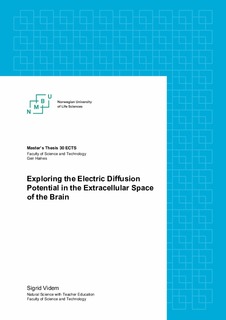| dc.description.abstract | Intense neuronal signalling may locally change the ionic composition of the extracellular space, and produce ionic concentration gradients. The ionic concentration gradients causes an electric diffusion potential, described by the Nernst--Planck equation. I have modelled this diffusion potential, by combining the Nernst--Planck equation with Kirchoff's law of current conservation, this is what is called the Kirchoff--Nernst--Planck-formalism \cite{Halnes2013}\cite{Halnes2016}. By assuming a laminar structure of the cortex, I made a one-dimensional model of the diffusion potential. The potential was simulated by implementing a numerical scheme in Python. I have found recorded concentration profiles from previously published experiments, where the extracellular concentration gradients were high, but not pathologically high. I used these concentration profiles as initial conditions. The aim of this project has been to investigate whether the diffusion potential makes up a measurable part of the extracellular potential. From previous studies \cite{Halnes2016}\cite{Gratiy2017}, I know that the diffusion potential has low frequencies, and its effect would be in the low-frequency part of the extracellular potential -- the local field potential. The the frequencies of the local field potential were analyzed by computing the power spectrum density. I found that for recordable frequencies (from 0.3 Hz and above) and non-pathological ion concentration gradients, the diffusion potential was much smaller than measured local field potential.
The concentration gradients are transient, and the baseline concentrations are re-established approximately hundred times faster than what diffusion accounts for \cite{CordingleySomjen}. I simulated a diffusion potential caused by exponentially decaying concentration gradients, with typical half-lives from previous experiments. This produced a diffusion potential with higher powers in the range of the recordable frequencies, but still not at the level of the recorded local field potential.
Some pathological conditions are associated with extreme concentration gradients. I have used a recorded concentration profile where the deviations from baseline concentrations were approximately ten times higher than the non-pathological concentration deviations. I saw that in this case, the diffusion potential was of the same magnitude as the local field potential, and even larger, for frequencies lower than approximately 2 Hz. I also tried this extreme scenario with exponentially decaying concentration gradients. This resulted in a diffusion potential which was larger than the local field potential for almost all frequencies in the range of the simulation. | nb_NO |

